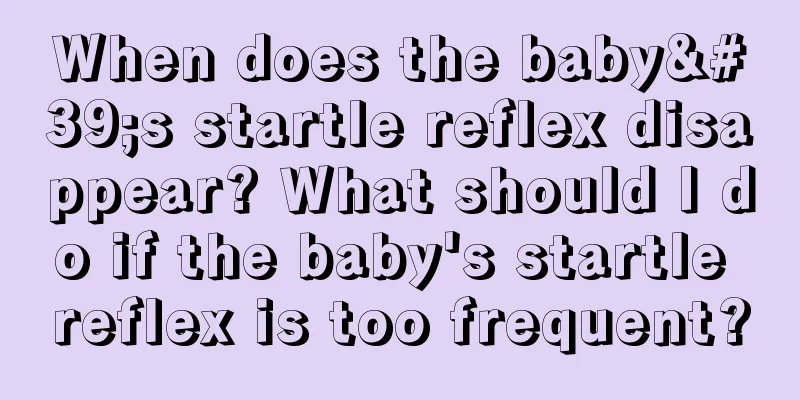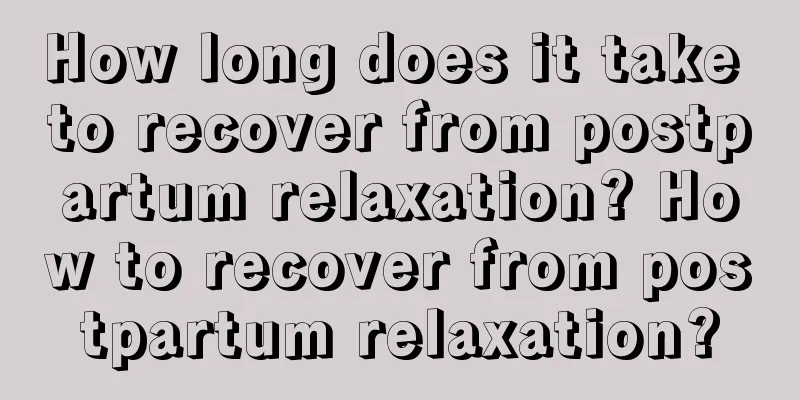When does the baby's startle reflex disappear? What should I do if the baby's startle reflex is too frequent?

|
If mothers find that their babies startle frequently when sleeping, don't worry too much. This is the baby's startle reaction, which is a normal physiological phenomenon. So when will the baby's startle reaction disappear? What should I do if the baby's startle reflex is too frequent? Baby who startles while sleepingMy baby has a severe startle reflex. He wakes up from time to time when sleeping, and sometimes scares himself to tears, which greatly affects his sleep. What should I do? Understanding the startle reflex The phenomenon of babies startling when sleeping is called startle reflex. The startle reflex, also known as Moro's reflex, is a defensive reflex induced by sudden strong sensory stimulation in humans or animals. It is manifested as rapid contraction of facial and body muscles, often accompanied by other unconscious protective action reactions. The startle reflex is not a bad thing, it has a protective function. In addition, we can also use the startle reflex to measure the functional development of the baby's cognition, attention and sensory motor integration process. As the baby grows, the regulation and adaptation process of the startle reflex will be gradually improved, and the startle reflex will gradually be relieved and eliminated. So, how long will it take for it to disappear? Generally speaking, newborn babies may be more sensitive, but the startle reflex will gradually decrease between 3 and 6 months, and will disappear at the latest in 6 months. 1. The baby is not sleeping well: The baby is not sleeping well means that he always likes to hum and moan, frowns with a painful facial expression, twists his body, cries, and other clinical symptoms such as not wanting to sleep or waking up easily when sleeping. 2. Sudden twitching while sleeping: Sudden twitching while sleeping is medically called intermittent nerve twitching, which occurs in most adults. This is a natural phenomenon. However, if it happens frequently and violently, it may be due to low blood calcium, which leads to hyperexcitability of nerves and muscles and spasms and twitching. Most babies are in a state of light sleep when they sleep. When they encounter sounds, light, vibrations, or changes in their body position, they will startle. When babies experience this irregular, systemic, short-term, uncoordinated shaking during sleep, parents do not need to be nervous, because it is not because the baby is frightened, but a normal physiological reaction. When will the baby's startle disappear?In layman's terms, the startle reflex refers to a symptom that a baby exhibits when he is startled or stimulated. This is an instinctive expression, but it will not exist for a long time. So when will the baby's startle disappear? The startle reflex is a temporary reflex in the neonatal period. Normally, the reflex disappears naturally 3-4 months after birth. To reduce the risk of startle reflex symptoms, make sure your baby sleeps on his back. By the time your baby is one month old, he may have developed a routine for eating and sleeping, but don't force him to follow it. At this stage, you should feed your baby whenever he shows signs of hunger, preferably before he starts crying. Newborns are most prone to the startle reflex. Some babies will experience this even when they are sleeping, but it will easily disappear after a few months. What to do if your baby has a severe startle reflexGenerally speaking, the startle reflex is not too serious and will disappear on its own. However, there are cases where it does not disappear for several months. What should I do if the baby's startle reflex is serious? If the baby does not develop these reflexes in the neonatal period, or if the reflexes do not disappear 3-4 months after birth, it is an indicator that we need to intervene. Diseases that may cause the startle reflex ① If the condition persists for more than 4 months: there may be neuropathy, ② If the condition persists for more than 6 months: there is definitely neuropathy, ③ Asymmetric reaction of the upper limbs: hemiplegia, brachial plexus injury, clavicle or humerus fracture, ④ Disappearance of lower limb reaction: lower spinal cord injury and congenital hip dislocation disappear in 3-4 months. Although the startle reflex is an instinctive action, if it is serious, it must be treated in time, otherwise it will affect the baby's health. How to deal with the startle reflexAvoid stimulus overload The fetus basically grows up and matures in a quiet environment. Once it is born, it comes to this bright and noisy world, which is very uncomfortable for it. It is natural for it to be startled and uneasy. Therefore, at this time, it must be given a relatively quiet and less stimulating environment to avoid noise, strong light and other stimuli. Develop adaptability The above mentioned stimulation should not be overloaded, which means that moderate stimulation is still needed, which is necessary for cultivating adaptability. For example, it cannot be absolutely silent. The baby's hearing and normal auditory reflexes should be trained under the stimulation of gentle natural sounds; his vision and visual reflexes should be trained under the stimulation of sufficient natural light. Because reflexes are the basic functions of the nervous system, including risk avoidance and defense reflexes. It is not to eliminate them, but to train them to develop to a higher level. That is to say, the higher-level centers should inhibit or regulate the blind orders of the lower-level centers, which will eliminate those excessive startle reflexes. The above two points are the general principles for eliminating the startle reflex. If you understand its biological and physiological principles, it will be easier for you to understand and master the following methods and measures. Plenty of massage and touch If babies are massaged every day after birth, it helps stimulate and inhibit primitive reflexes. Babies under one year old can be touched. Touch and caress exercises can encourage babies to find similar feelings and experiences in the surrounding environment, so as to continuously improve themselves. Children over one year old should also be given tactile training (including tactile, thermal, pressure and weight perception training, etc.). Tactile exercises allow children to continuously improve themselves through "touch", which can not only improve the ability to distinguish various tactile sensations that are gradually similar but slightly different, but also improve the ability of children to control their own movements. Moderate packaging The tightness of the swaddle should be moderate. Too loose or too tight will make the baby feel uncomfortable. Do not use cloth belts to tie the swaddle tightly. Too tight binding is not conducive to the free movement of the baby's limbs and affects growth and development. Relaxation exercises Exercise can help babies learn to control their bodies. Babies under 6 months old should do at least 30 minutes of passive exercise every day, and do as many prone movements as possible. Inner ear vestibular stimulation The structure of the inner ear is very complex, including the auditory nerve and vestibular nerve endings. The sensory information generated by stimulating the inner ear nerve endings is very important, especially the vestibular organ of the inner ear has the ability to regulate the body's balance. Stimulating the baby's inner ear vestibule is mainly done through exercise, such as clapping games, rolling flat, rolling forward, shaking, bouncing up and down, and swinging. However, the movements must be moderate. Improper activities may cause discomfort to the baby, and in severe cases may damage the baby's brain development. Scientific exercises should be carried out under the guidance of professional teachers. Each exercise should not exceed two minutes, and the exercises should be carried out several times a day. Special reminder: Do not give your baby pearl powder or tranquilizers Because tranquilizers have an impact on the baby's central nervous system, for example, the main ingredient of "Child Jingfeng Powder" is cinnabar, which poses a risk of mercury poisoning! Pearl powder contains a high amount of calcium, and excessive calcium supplementation will cause premature calcification of the baby's bones, affecting future height; pearl powder is a powdery substance that is insoluble in water, and the baby's digestive system is very weak and easily harmed; the purity of pearl powder on the market is not high, and many manufacturers grind shells into powder and sell them as pearl powder, so be careful; there are a lot of inferior pearl powders on the market, and some even contain lead, which is extremely harmful to infants and young children! So don't be fooled by quack doctors and abuse such drugs. |
<<: What are the benefits of giving your baby massage? Massage techniques illustrated
>>: Will eating pork belly make childbirth smoother? How to make childbirth smoother
Recommend
Why can't cod liver oil be taken for a long time? What is the difference between cod liver oil and deep sea fish oil?
Cod liver oil is a nutritional supplement. Genera...
What services are included in a doula delivery? Does a doula delivery require an episiotomy?
Before giving birth, many mothers heard that the ...
Can't eat salt during confinement? Eat salt in moderation
There are many taboos during the confinement peri...
Are pears high in calories? Can you eat pears while losing weight?
Pears are a fruit with high nutritional value and...
What is good for baby's oral ulcer? What can baby's oral ulcer heal quickly?
What should babies eat for oral ulcers? In summer...
Is corporal punishment really effective? The harm of corporal punishment of children
Many parents still follow the principle of spanki...
What should I do if my child doesn't like to eat vegetables? How can I guide my child if he doesn't like to eat vegetables?
What should I do if my child doesn't like to ...
How to effectively reduce behavioral problems in young children
Sometimes parents have a headache and don't k...
How to effectively treat severe postpartum hair loss? What are the causes of postpartum hair loss?
Many pregnant women will experience various physi...
How often should a newborn baby be bathed? What is the appropriate temperature for bathing a newborn baby?
Newborns have a high metabolism, and their bodies...
Which has a higher success rate, artificial insemination or IVF? The difference between artificial insemination and IVF
Artificial insemination and IVF are both advanced...
Symptoms of overnutrition in pregnant women Effects of overnutrition in pregnant women on the fetus
The physical condition of a pregnant woman is ver...
What color mosquito net is good for babies? How to choose a mosquito net for babies
Summer is here, and the most physical way to prev...
How long does it take for menstruation to come after an abortion? What should I eat to nourish my body?
Some women do not have their periods for a long t...
How to prevent your baby from getting lost: 6 tips you must know
In recent years, there have been many cases of ba...









